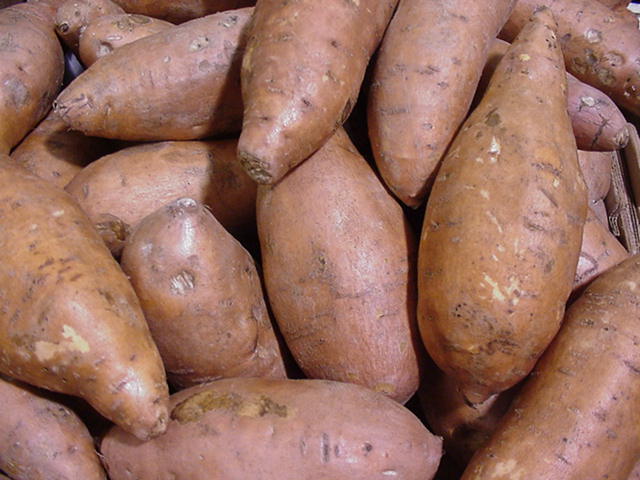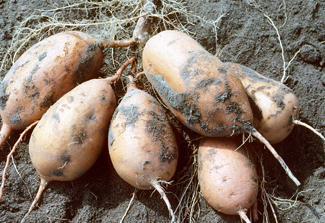Sweet Potatoes
The terms “sweet potato” and “yam” are often used interchangeably; however, they are actually two entirely different crops. Only sweet potatoes (Ipomoea batatas) are grown in the U.S.; yams (Dioscorea spp.) are grown in the Caribbean and many other tropical areas.
Marketing
 The most profitable marketing opportunities for sweet potatoes in Kentucky are through local fresh markets, such as farmers markets, direct delivery and CSA, and on-farm stands. Producers also market through local wholesale channels, selling directly from the farm to restaurants, grocers and institutional foodservice, including schools. “U-Dig” sweet potato sales, similar to U-Pick, are also possible in some areas. Sweet potato processing has grown nationally in recent years and is dominated by large processors; there are no significant processing markets available in Kentucky. Higher market prices tend to occur during the winter months; growers who are able to cure and store their crop may realize greater profitability. As of the 2018 season, there were no large-scale sweet potato curing facilities in Kentucky. Small-scale, on-farm curing is possible under properly managed conditions. U.S. sweet potato use per capita increased by about 2 pounds per person from 2006, reaching an estimated 7.2 pounds in 2016. More consumer familiarity with fresh sweet potatoes and increases in sweet potato fry consumption contribute to the increase. Sweet potatoes gained some popularity as a “lower-carb potato” in the early 2000s, and high antioxidant levels in sweet potato skins and other health benefits have contributed to sustained consumer appeal. Sweet potato consumption is highest among Americans over 60, and sweet potatoes may have special appeal to aging, health-conscious baby boomers. White and purple flesh sweet potatoes, as well as organic sweet potatoes, are possible market niches that Kentucky growers could fill.
The most profitable marketing opportunities for sweet potatoes in Kentucky are through local fresh markets, such as farmers markets, direct delivery and CSA, and on-farm stands. Producers also market through local wholesale channels, selling directly from the farm to restaurants, grocers and institutional foodservice, including schools. “U-Dig” sweet potato sales, similar to U-Pick, are also possible in some areas. Sweet potato processing has grown nationally in recent years and is dominated by large processors; there are no significant processing markets available in Kentucky. Higher market prices tend to occur during the winter months; growers who are able to cure and store their crop may realize greater profitability. As of the 2018 season, there were no large-scale sweet potato curing facilities in Kentucky. Small-scale, on-farm curing is possible under properly managed conditions. U.S. sweet potato use per capita increased by about 2 pounds per person from 2006, reaching an estimated 7.2 pounds in 2016. More consumer familiarity with fresh sweet potatoes and increases in sweet potato fry consumption contribute to the increase. Sweet potatoes gained some popularity as a “lower-carb potato” in the early 2000s, and high antioxidant levels in sweet potato skins and other health benefits have contributed to sustained consumer appeal. Sweet potato consumption is highest among Americans over 60, and sweet potatoes may have special appeal to aging, health-conscious baby boomers. White and purple flesh sweet potatoes, as well as organic sweet potatoes, are possible market niches that Kentucky growers could fill.
Production
 There are hundreds of sweet potato cultivars available, including heirloom varieties. Sweet potatoes differ in such horticultural characteristics as root shape, skin color (copper, rose, red, white or purple), and flesh color (orange, deep orange, purple, white or cream). Flavor (sweetness) and flesh moisture can also vary. Asian and Hispanic consumers often prefer dry flesh types. Because some cultivars require the lengthy growing season found farther south, it is important to select only cultivars known to be well-adapted for the Kentucky growing season. The growing season in Eastern Kentucky is about 90 days on average and Western Kentucky has 110 days fairly consistently. Resistance to various diseases (e.g. root knot nematode, internal cork and/or Fusarium wilt) and insects (e.g. wireworm) is available in some cultivars, although the slips (vine cuttings) may be very difficult to obtain. Commercial growers should choose varieties with the qualities in demand by the intended market.
There are hundreds of sweet potato cultivars available, including heirloom varieties. Sweet potatoes differ in such horticultural characteristics as root shape, skin color (copper, rose, red, white or purple), and flesh color (orange, deep orange, purple, white or cream). Flavor (sweetness) and flesh moisture can also vary. Asian and Hispanic consumers often prefer dry flesh types. Because some cultivars require the lengthy growing season found farther south, it is important to select only cultivars known to be well-adapted for the Kentucky growing season. The growing season in Eastern Kentucky is about 90 days on average and Western Kentucky has 110 days fairly consistently. Resistance to various diseases (e.g. root knot nematode, internal cork and/or Fusarium wilt) and insects (e.g. wireworm) is available in some cultivars, although the slips (vine cuttings) may be very difficult to obtain. Commercial growers should choose varieties with the qualities in demand by the intended market.

